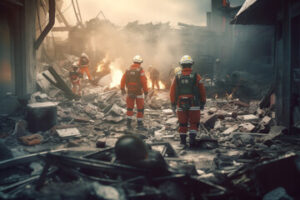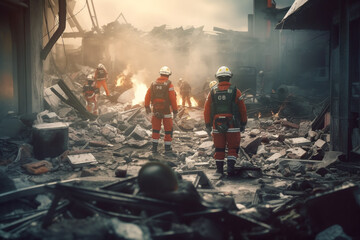The government uses contracts to support disaster relief efforts. For example, a Disaster Response Registry was established to list contractors who are interested in performing debris removal, distribution of supplies, and reconstruction. This database is accessible through technical assistance centers.
Before submitting any contracts, businesses should register within the system for the award database and have their registration verified. Task Force Labor also declares its codes, which are used to identify businesses for disaster relief contracting.

They Are Responsible For Cleaning Up After A Disaster
The aftermath of a disaster can be a chaotic and dangerous time, and disaster relief contractors play an important role in providing help to affected people. They are responsible for repairing damage, cleaning up debris, and other tasks. They can also provide food, water, and other supplies. In some cases, they can even provide shelter. The jobs are usually difficult and involve a lot of hard work. However, they can be extremely rewarding, especially if you have the right skills.
A disaster recovery contractor is a unique type of worker, and they need a specific set of skills to do their job. These workers are a mix of first responders and cleanup crews, and they often work long hours. They may be called upon to free a family trapped in a house, or they might tie down tarps to prevent rain from further damaging a home. They also need to be prepared for dangerous situations, such as downed power lines and fallen trees. In addition, they must be familiar with government contracts and procedures.
If you want to become a disaster relief contractor, it’s a good idea to get started early. You should register with your state emergency management agency and the emergency management agency. You can also register with the system for the award management database, so you’re ready to start work when a disaster strikes.
Many different agencies rely on contractors to help with disaster relief, including the Forest Service, and the military. Some of these agencies are more likely to need specialized companies, such as those that provide security services or can set up emergency fencing. Other agencies need more general contractors, such as those who can repair damaged buildings or clear away debris after a hurricane.
Small businesses can become disaster relief contractors by registering with the system for the award management database and declaring their codes. This is an important step in preparing for a potential disaster because the federal government will not pay you if you’re not registered.
Disaster relief can be an unpredictable environment, and it’s not unusual for unethical or corrupt practices to arise in the wake of a natural disaster. It’s important to be aware of the risks and be ready to report unethical behavior. The division is ready to investigate and prosecute individuals or companies that attempt to abuse the disaster recovery process.
They Are Part Of An Agency
The emergency management agency is an organization that provides support for communities affected by disasters. The agency works in partnership with state and local governments, as well as with private companies and volunteer organizations. The agency also provides training and assistance to individuals who want to get involved in disaster relief efforts.
Disaster relief contractors are needed after natural disasters to help rebuild destroyed buildings, clear debris, and repair infrastructure. They often work on a contract basis and may be required to travel to the site of a disaster to provide services. These contractors should be prepared for this type of work and have experience in the field. They should also be able to communicate effectively and understand the importance of a timely response to requests for assistance.
In 2017, hurricanes caused widespread damage to the country while wildfires killed hundreds of people and forced millions of others from their homes. In response, the government rushed to send relief workers and supplies, including food, water, and shelter. However, the agency has faced numerous challenges in its attempts to respond quickly and efficiently.
A key problem has been the lack of training for relief workers. While emergency management agency has several training classes, most of them are offered only at its centers, through programs in the community, or online. The agency is also struggling to keep up with the number of volunteers, who are needed to perform the many tasks required in a disaster response.
To help with this, the agency has begun to use advance contracts, which are established before a disaster occurs. These contracts make it easier for agencies to respond to a disaster with essential goods and services. These contracts are especially helpful for smaller businesses that might otherwise not be able to compete with larger organizations with greater resources.
The agency also uses disaster relief grants to provide financial aid to citizens. These grants can be used to pay for housing, medical expenses, and other needs. However, it is important to note that these grants are not intended to cover all costs associated with a disaster. For this reason, homeowners should consider getting comprehensive home insurance to protect themselves against natural disasters.
They Are Part Of The Database
When national disasters occur, supplies and services need to be procured and rushed to affected areas quickly. Small businesses can contract with the federal government to perform these tasks. To help with this effort, the system for award management includes a Disaster Response Registry. This registry lists contractors that are willing to perform debris removal, distribution of supplies, reconstruction, and other emergency or disaster relief services.
Disaster recovery operations require a wide range of services and support to meet the needs of survivors, including clearing debris, furnishing facilities, and providing water, power, and sanitation infrastructure. These operations may be led by the federal government through the agency, state or city disaster response programs, or non-profit organizations like the Red Cross. Several steps need to be taken by business owners to prepare to bid on these contracts, including obtaining a number and registering with emergency management.
The database is used by procurement agents from the federal government to find vendors that can perform a certain task. To be considered for a job, businesses must have an active agency management account and be categorized under the appropriate code. The website provides a search tool that allows users to filter by codes, keywords, and other criteria. Once a business is registered, it can receive notifications of new contract opportunities.
For smaller businesses, the best way to position themselves for disaster recovery work is to get on the preferred vendor lists of local counties, cities, and towns. The process for getting on these lists varies from county to county, but it is usually quite easy. Many large counties will even provide bonding pre-qualification assistance to potential applicants.
The Department of Security, which oversees the database, will release solicitations for opportunities related to disaster recovery. This information can be accessed by logging in to the website and navigating to the “Assertions” module. In addition, there is a network across the country that can assist businesses with positioning themselves for disaster response contracting opportunities.
They Are Paid By The Government
The disasters of recent years have made the government look for contractors to help in the clean-up and rebuilding effort that follows cataclysmic events. Many companies are ready to take part in this effort, but it’s important to understand how the process works before you decide to sign up. During a disaster, potential contractors swarm to the area, and it can be chaotic, confusing, and cutthroat. Unscrupulous third-party firms may charge hefty fees for the privilege of being placed on a list of “priority vendors.” In addition, local officials are overwhelmed and can be difficult to communicate with.
The first step in becoming a disaster relief contractor is to register with the system for award management. Once you’ve registered, you must declare your codes. This is how the government classifies industries and determines which companies are qualified to provide services. The more specific your code, the better your chances of being awarded a contract. In addition, you should contact your local technical assistance center to get help in registering. Technical assistance centers are a nationwide network of procurement professionals who offer free government contracting assistance to small businesses.
State and local governments are often the first responders to disasters, but when their needs exceed their resources, they may notify an emergency management agency. The agency is then responsible for coordinating federal disaster response. It can address the needs directly or through mission assignments, which are work orders issued to other federal agencies allowing them to perform certain disaster response functions.
Although there are several different types of contracts offered by the government for disaster response, the most common ones are service contracts, construction projects, and professional services. Construction projects are particularly important for long-term recovery efforts and can involve many different aspects of the work, including demolition, construction, and environmental mitigation. Services include emergency plumbing, electrical work, roof repairs, and temporary shelters. The government also awards grants for rebuilding communities that are damaged by disasters. These grants are often used to build new roads and bridges and help rebuild public buildings. They can also be used to purchase new tools, equipment, and vehicles.

